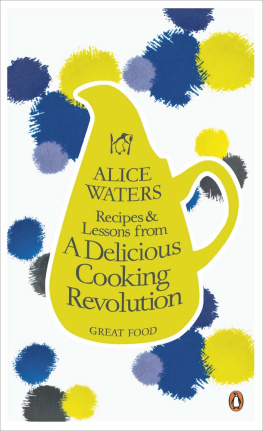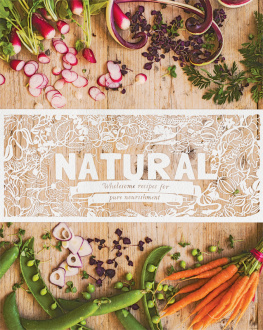Fourth Estate
An imprint of HarperCollins Publishers
77-85 Fulham Palace Road,
Hammersmith, London W6 8JB
www.harpercollins.co.uk
First published in Great Britain by Fourth Estate in 2013
Copyright Daylesford 2013
Daylesford asserts the moral right to be identified as the author of this work
A catalogue record for this book is available from the British Library
All rights reserved under International and Pan-American Copyright Conventions. By payment of the required fees, you have been granted the non-exclusive, non-transferable right to access and read the text of this e-book on-screen. No part of this text may be reproduced, transmitted, down-loaded, decompiled, reverse engineered, or stored in or introduced into any information storage and retrieval system, in any form or by any means, whether electronic or mechanical, now known or hereinafter invented, without the express written permission of HarperCollins
Source ISBN: 9780007274796
Ebook Edition AUG 2013 ISBN: 9780007356447
Version: 2013-07-24
Everything we do at Daylesford is governed by the natural rhythm of the seasons, from the animal husbandry to the taste of the milk and cheese, which changes subtly as the herds move from pasture to pasture. Spring, summer, autumn and winter are our constant watchwords, each season eagerly anticipated, each bringing particular treasures straight from the market garden into the kitchens. From the first purple sprouting broccoli and rhubarb into the colourful summer riot of tomatoes and berries, and on through the autumnal pumpkins, squash and orchard fruits, we make the most of everything we grow or source seasonally, in as many dishes as possible. And when we have a glut, it is all hands to the deck, making jams and chutneys and pickles, in order to capture the essence of one season to enjoy in another.
Of course some produce has an extended season, or more than one season, or it grows for most of the year, so there will be different combinations of fruit and vegetables to enjoy as the seasons change.
Other marriages are available to us for all too brief a time, so are not to be missed, and you will find some of these on the following pages.
Spring
Summer
High Summer
Autumn
Winter

It seemed so simple and obvious that it was all about the soil.
What we are really trying to do here at Daylesford is to take a step back in time and re-learn the skills and values of our grand-parents generation, when country people had a kitchen garden or an allotment and ate whatever they grew. If they had a small-holding or farm, they raised crops to feed whatever animals they had, which in time would be slaughtered to feed the family. You might have a few hens for eggs, or a pig, or a cow to milk, so you might make butter and cheese, and it was all healthy and fresh and self-sustaining.
I grew up in the countryside in the Midlands, not on a farm, but close to farming, and the way we shopped was very simple. On Sunday we had a joint of meat or a chicken, which was a real treat that you had once every two weeks or so. Monday would be leftovers day, then on Tuesday we would shop afresh for the week, at the butchers shop, the bakery and the cheesemongers, and the fishmongers on Friday, which was always fish day. Everyone in the shop knew your name and what you liked, and it is that personal connection with food and the people who grow it and raise it that we are trying to achieve at Daylesford.
I really didnt mean for the project to have grown as it has done; one thing just led to another. It started with wanting to make a difference, on a small, family level, after two chance incidents. The first was when we were living and farming at Wootton in Stafford-shire thirty-six years ago. I was in the garden with my eldest child, Alice, who was only six months old. I was pushing her in the pram and we went to look at some roses I had planted a few days before, and found they were wilting. This was the seventies, when like everyone we had big fields, because all the hedgerows had been taken out, and it turned out they were spraying Roundup on the farm. I didnt even know what Roundup was, but I soon learned it was a very powerful herbicide, and that the toxins had carried in the air from the fields and affected the roses. As a new mother, I was horrified. That was the beginning of thinking that we couldnt carry on farming as we were.
Then, a little later, I was at an agricultural show, again with Alice in the pushchair, and the Soil Association had a little tent there. The organic movement was quite a small, niche thing in those days, but I went inside and talked for about an hour and a half to a man who was so inspiring; it was a real open-window moment. That night I said to my husband, We cant carry on farming as we are. We are ruining the soil and the environment with chemicals, for our babies, and for future generations. We have to stop and think about what we are doing. It seemed so simple and obvious to me that it was all about the soil. Unless you look after the health of the soil, you dont have good plants, and so you arent producing healthy food for us or for our animals. So we went to see the farm manager, who didnt really believe it was possible, but I was quite determined, and after a few years he realised it was the right thing to do.
That was the start. We were farming deer, Aberdeen Angus cattle, sheep and chickens, then we came to Gloucestershire in 1992 and again, the first thing we did was convert the land to become organic. It took a long time for it to clean itself, because of the chemicals that had been used previously, but suddenly wonderful things started happening, wild flowers and plants that hadnt been seen before began appearing in the undergrowth; I remember particularly seeing so many different kinds of violets growing. Everything comes back to the soil, and ours began to be rich and dark and alive with worms: a totally different colour to soil that has had chemicals in it.
I think there is no other way to farm, but organic has become a difficult word, because it has been abused I dont want to eat organic food that has come into the supermarket from 3,000 miles away and has been picked at the wrong time of year. So we prefer to talk about food that is local, seasonal and sustainable.
When we arrived at Daylesford we also inherited a dairy herd, so we were able to have our own milk there is something wonderful about fresh farm milk that has a flavour you remember from childhood. And so I thought, Why dont we make cheese? But how on earth was I to find a cheesemaker? I bought a copy of the Specialist Cheesemakers Association magazine and rang the editor, who happened to live in Chipping Norton, and he said, Its funny you should call. There is an American cheese-maker called Joe Schneider ... Joes passion was British farmhouse cheese, and he was the first person I employed. We put together a plan and he started making our first Cheddar, which we matured for ten to eighteen months, greased with our own organic lard from our cattle and wrapped in organic muslin, and I hand-wrote the first labels. We wanted to take the artisan process as far as we could and be correct and ethical to the nth degree. We were very lucky, in that the Cheddar won a gold award the first year. I love our Cheddar and I am very proud of it. I like to see the cheeses in the maturing room, and the constant checking to see how they are coming along. Cheese-making is truly the work of the hands.














